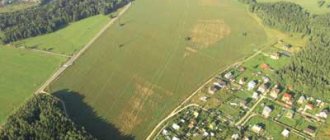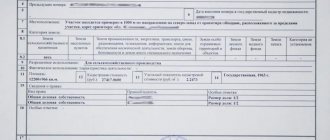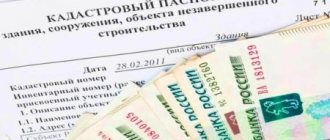Free legal consultation!
To carry out purchase and sale transactions and other real estate transactions, you must know the cadastral number of the property. If this numerical code is recorded, then this indicates that the plot or premises is registered by the cadastral chamber. The responsibilities of the administrative body include determining the boundaries of land plots, conducting land surveying, as well as the entire range of cadastral operations. The importance of having a cadastral number is determined by the provisions on real estate transactions, which may become impossible in the absence of personal registration.
What it is
When completing transactions with real estate, its owners often have the question of what exactly a cadastral or individual number is by legal designation. According to the law, during cadastral and technical registration, each object belonging to the category of real estate is assigned an individual number, which is considered to be a cadastral number. The personal code is entered into the register and is confirmation of the right to property. Entering a digital or alphanumeric code into the cadastre is necessary to identify the object. Using the number code, you can determine the exact location of the site.
What is it needed for
A cadastral number is a unique set of numbers in all databases of the Russian Federation. It is assigned separately to each property when it is registered with the state. The latter is implemented in strict accordance with the procedure regulated by the Russian legislative framework, namely the Federal Law “On state registration of rights to real estate and transactions with it.” The cadastral number is assigned to the object as long as it exists in the form of a single legal object. It allows you to quickly obtain comprehensive information about the site or building to which it has been assigned.
The cadastral number is retained for the entire period of existence of the land plot as such. It must be entered into the electronic databases of the local administration. There can be no grounds for changing the cadastral number. Even a change in the owner of a land plot or its intended purpose is not considered a sufficient reason for changing its number value.
The cadastral quarter of a land plot is the boundary of the building lines within each base quarter. This is the minimum territorial division into which cadastral districts are divided after the authorized bodies determine and adopt the cadastral zoning scheme for a separate subject of the federation.
Cadastral zoning is done by districts and blocks
Base and cadastral blocks always have the same numbers. The procedure for maintaining records of all cadastral numbers that have ceased to exist or have only recently been formed is regulated by regulations of the Federal Land Cadastre Service of Russia. But the procedure for assigning numbers is established by another body - the Government of the Russian Federation.
The cadastral number by default implies the structuring of territories. In this case, structuring is a division into separate structural objects - zones, blocks, etc. When creating a structural division of territories, land plots should not intersect with each other in any way, and there should be no breaks. The entire process takes place on the basis of an up-to-date and truthful cartographic image of the territory.
The land cadastre itself is divided into three levels:
- federal, which covers the entire territory of the Russian Federation;
- subjective, which divides lands into edges, regions and other entities;
- local within local government.
Cadastral quarter is a unit of division of cadastral districts. This is a limited area in which land plots are located. Each land plot has its own unique number, which is necessary for its identification according to cadastral registration databases.
How to decipher the site number
When deciphering a digital record entered into the state cadastre, the groups of numbers present in it are considered. The total numerical value is distributed into 4 groups, often separated by signs. Each category of numbers carries its own information load. In this case, the rule of absolute uniqueness of the code is observed. The number assigned to the property is deciphered as follows:
- the first digits determine the regional affiliation of the object;
- the next digital group indicates the territorial district, which is the location of the object;
- the third block gives information about the quarter;
- the final fourth digital combination stores information about the object itself, this is the personal number of the site.
In order to correctly decipher the information hidden in the individual code, you need to know which territorial units are designated by different digital combinations. An electronic map can help with this.
What does it consist of?
The structure of the cadastral number of a land plot consists of twelve or more digits , connected in pairs and groups, separated by colons. Spaces are allowed in the third sector
. Twelve digits is the standard into which real estate in small regions located in central Russia fits.
The East, North-Eastern zone of the country, the middle and northern Urals are distinguished by large cities, in which not only vast land masses, but also numerous buildings that require registration and accounting.
Accordingly, the cipher here is much more complex and has more characters in the third and fourth sectors. Numbers are also arranged in groups, separated by colons, allowing spaces.
The same can be said about such major centers of federal significance as Moscow and St. Petersburg . The city of Sochi, which has been upset in recent years, belongs to the same category of centers whose cadastral numbers allow for going beyond the regulations established in 2021.
In the capital and other centers there are also standard twelve-digit numbers that characterize the initial registration of real estate, starting in 2021. Subsequently, with the filling of the initial structure of the codes, the need arose to expand it.
It is noteworthy that the structure of the cadastral number of a real estate property always assumes the first digits in the amount of 2 pieces. They completely coincide with the number of the region where the land plot or building is located. These signs are completely identical to those indicated on vehicles registered in a particular county.
Structure of the cadastral number of a land plot
All numbered designations of objects must be subject to the general rule. According to the established structural format, what the numeric or alphanumeric inventory combination looks like is important. The first two digits indicate the cadastral district, the next two indicate the cadastral district, the four- or six-digit combination that follows indicates the quarterly location of the site. The last four digits contain information about the object itself. In total, an individual number can have from 10 to 16 digits. The standard option is 13 digits.
Varieties
The cadastral number and its individual parts have their own structure and interpretation. They come in old and new styles, have a certain number of numbers and digital blocks, each of which has its own definition.
Read about all this below.
Old and new
In 2007, further changes were made to the land legislation of Russia, which entailed the introduction of a modern format for the cadastral number and the term itself.
This happened against the backdrop of the reformation and renaming of the country’s main cadastral body into the modern State Real Estate Cadastre - State Real Estate Cadastre.
Before this legislative reform, the cadastral number did not exist in our usual form, and since 1992 it was designated by an accounting code, similar to the modern one, but with several more digital blocks.
If the current code looks in the format “ХХ:ХХ:ХХХХХХХ:ХХ”, then in those days it looked like this: “ХХ:ХХ:ХХХХХХХ:ХХ:Х:Х”, where the last two “:Х:Х” are digital designations of specific buildings on a given site (house, barn, garage, etc.).
Thus, by its appearance, focusing on how many digits are in the code, you can understand whether this is a new cadastral number or an old one.
In the modern version of the cadastral number, buildings on a land plot are not taken into account , since a separate numerical identifier is now provided for them.
Format and transcript
As you saw in the example, the new cadastral numbers consist of four digital blocks , arranged in a strictly defined order. Each of them has its own function to designate.
For example, let’s take a random plot found on a public cadastral map (there is a separate article about it), and decipher its cadastral number - 13:19:0202001:53.
- Block one (13) – the first is always the numerical code of the cadastral district . In our case, this is the code of the Republic of Mordovia.
- Block two (19) – the second is the number of the cadastral district defined for this district. In our case, this is the Temnikovsky district.
- The third numerical block (0202001) means cadastral quarter .
- In the last, fourth block (53) the numeric code of the land plot itself .
The first block of the cadastral number contains 2 digits, the second - the same number. The third block has 7 digits, the fourth block has 2. In total, 13 digits in the entire KN.
Example of a cadastral number
An example of what such a number looks like will help you more accurately understand how to correctly decipher it. Symbols of territorial units are transmitted by digital code.
Examples:
| 68:20:2101007:44 | Tambov Region | Tambov district | Streltsy village | St. South, house number |
| 47:23:1203001:810 | Leningrad region | Gatchina district | Gatchina | Coordinates of the site in the register - street, house number with fraction |
You can find out what the digital combination means in online resources. Typically, the first block of the cadastral cipher is equivalent to the number combinations of vehicles in the region. The third block of the cadastral code contains the largest amount of information. It contains the coordinates of the zone, array and quarter.
Validity periods of documents
Despite the fact that the legislation does not establish clear validity periods for extracts received from the Unified State Register and the State Property Committee, they may be limited by the institutions where these papers must be provided. This is explained by the fact that legal information may lose its relevance if the owner of the object changes.
Please note that sometimes the validity of the certificate is limited to one day.
The usual validity period for an extract is 1 month, but experts recommend using documents that have been received no more than 2-3 days. This is especially important for trade or transfer transactions with real estate.
As for the State Property Committee, you need to understand that the law establishes the obligation for the relevant services to re-evaluate the cadastral value of real estate every five years. Of course, after it is carried out, the changed information is displayed in the registry.
Obtaining information via the Internet
You can find out detailed information about the site using online sources. If you have a cadastral number, this is not difficult to do. A schematic representation of any registered plot can be found on a special cadastral map. The electronic version of the state register is available around the clock and contains complete information about all real estate objects that have an individual state registration code. There is no charge for submitting a site plan electronically.
Important! The disadvantage of this method of obtaining information about the desired object is possible errors in the information due to the provision of outdated information.
A more reliable option for cadastral research is to go to the Rosreestr website. After submitting an official application, the application will be reviewed within 5–10 days.
The sequence of actions when submitting a request to Rosreestr is as follows:
- Log in to the official website of the company.
- In the Electronic Services category, find the Go to Sections button.
- Next, find Help information in the services.
- Fill out the feedback form, indicating the exact postal address of the object.
- Next, you need to type Create a request.
In response to the request, information on the site will be provided. An extract can be obtained by applying online and by visiting territorial departments. To obtain an extract on the Rosreestr website you will need to do the following:
- Determine personal status in a special category - individual or legal entity.
- In the Electronic Services section, select Receiving data from the Unified State Register of Real Estate with the ability to draw up a cadastral plan.
- Enter the required data into the form.
- Determine the option for receiving an extract.
- Provide an email address to send documentation electronically.
- At the final stage, you need to make sure that all data is entered correctly.
Non-standard situations
From time to time, private, non-standard situations related to the cadastral number occur. We will describe here the most common such legal incidents.
If a land plot does not have a cadastral number, it means that cadastral work related to surveying and establishing precise boundaries was not carried out in a timely manner. Data on such plots are not included in Rosreestr or another cadastral body and the ownership of it seems very doubtful, due to the legal dysfunction of all documents on it.
Other ways to find out the cadastral number of a property
In addition to obtaining information from Internet sources about an individual number in the cadastre, you can use other available methods to resolve this issue. The most acceptable option is to contact the cadastral chamber, which is located in the city or district administration at the place of registration of the site. This option eliminates the possibility of error, since all information is carefully checked.
To apply, you only need a passport. You will also need to indicate the exact address of the facility. Based on the information provided, an employee of the administrative unit will search for information using the available coordinates. Contacting an official institution allows you to obtain the necessary document based on reliable information.
Private companies also provide information about sites. This type of service is provided on a paid basis. The cost may vary and range from 600 to 2000 rubles. The advantage of this method of obtaining information about a land plot is the possibility of providing express services. Specialized companies provide the following information:
- site plan;
- location of permanent and non-permanent buildings;
- exact cadastral code;
- number of storeys of buildings;
- date of registration of the object with state registration;
- area parameters;
- property type.
Some information can be obtained independently using the available data in the cadastral passport. Typically, column No. 1 contains information about the registration number. Column No. 11 establishes the cadastral value of the property. For greater reliability, when obtaining information independently, you should use at least two sources - the object’s passport and an online map.
OKS; decoding in the cadastre
By the way! Finished buildings can be transferred to the status of capital construction projects. This is possible if significant redevelopment or expansion is carried out. A similar rule applies to buildings.
Important! According to the provisions of the Housing Code of the Russian Federation, the area of residential real estate is calculated without balconies and loggias. All unheated premises are excluded from the list taken into account when calculating the indicator.
The total area of the facility is prescribed in a well-developed and compiled OKS plan. Essentially, this is a document that contains data:
Useful features, what to do if there is no number
A personal number is issued during the privatization of a plot if there is a right to the property and the boundaries have been agreed upon. Due to the fact that the presence of a number in the cadastre is not mandatory, a situation may arise when the owner of the object does not have a code. Such an omission may complicate the following real estate transactions:
- conducting property disputes;
- carrying out a purchase and sale transaction;
- legal proceedings regarding the legality of the right of ownership of property by the current owner;
- the need to formalize a deed of gift;
- drawing up a will for this object;
- registration of a mortgage secured by the plot;
- object insurance.
Doubling
Since until 2013, real estate registration did not take place in a single database, cases of duplicate cadastral numbers are possible. This happens because data is entered into the state cadastre in two ways:
- registration of land plots in the prescribed manner in Rosreestr;
- supplementing the unified database with information about previously registered objects.
Therefore, it is possible to assign two numbers to one plot. In any case, this is the result of an error by Rosreestr employees. To clarify the data, you should make an extract from the Unified State Register. If an error is detected, you will need to contact the Rosreestr office with a request to correct the data. If there is a refusal, you need to send a statement of claim to the judicial authorities.









